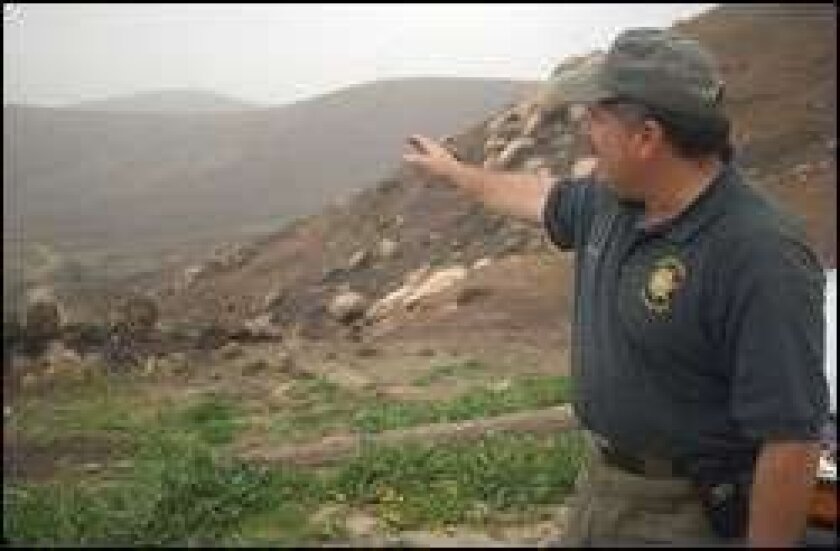Burned parks remain closed months after fires
By GIG CONAUGHTON – Staff Writer March 15, 200412 AM


NORTH COUNTY — New grass is beginning to cover the soot-encrusted earth, but nearly five months after San Diego County’s wildfires, the gates to Poway’s Sycamore-Goodan Ranch preserve remain padlocked, and placards with red letters stating”park temporarily closed — no trespassing” hang like crooked patches over its welcome sign.
Similar signs and locks remain in place at 10 other county parks, and officials said last week they have no idea when the parks could be reopened.
County parks officials say they are struggling to comply with federal demands for satellite mapping of all the damaged and hazardous trees that must be removed, and haggling with insurers –as are residents who lost their homes in the fires — to get the cash needed to replace buildings and equipment in the parks.
Meanwhile, San Diego County’s chief administrative officer, Walk Ekard, has raised the specter that some parks could be closed for along time. Ekard said some damaged parks could be kept closed to save the county money if the state’s budget woes cut deep enough into the county’s funding.
Last week, as parks Director Renee Bahl surveyed the wreckage at Goodan Ranch, she said she was encouraged by the newly sprouting greenery, but that the immediate future of Sycamore-Goodan, and the other parks, is hazy.
“It’s impossible to tell (when the parks will be reopened),” she said. “It’s probably going to be a phased process for many parks.What it comes down to is, is it safe for the public to be here?”
Thousands of acres burned
Bahl said more than 15,000 acres of the county’s total 40,000acres of parkland were scorched by the October wildfires. Some of the other closed parks include Valley Center’s Hellhole Canyon Open Space Preserve; Lakeside’s El Capitan, Oakoasis and Stelzer parks;Ramona’s Mt. Gower Open Space Preserve, Julian’s Heise park, and parts of San Diego’s Mission Trails Regional Park.
She said about 1 million people a year visit the county’s 80 park facilities, which include local and regional parks, fishing lakes, community centers, ecological preserves and open space.Officials don’t have exact attendance figures specifically for the burned parks.
A complete rehabilitation of the damaged parks — rebuildingl ost structures and letting Mother Nature completely regrow the torched vegetation — will probably take at least three years, Bahl said.
But she said parts of the parks could be reopened fairly quickly if those areas could be made safe to visitors.
To do that, workers must remove debris, such as incinerated cars and equipment, as well as the sooty remains of signs, ranger residences, cabins, barns, fencing and campsites that were destroyed.
They also must remove damaged trees that are close enough to trails and public areas that they might fall over and hurt people,or where burned root systems could create dangerous sinkholes.
Tree removal held up
The tree-removal process has created the biggest hiccup in the rehabilitation, Bahl said.
The Federal Emergency Management Administration is the organization that would reimburse the county for removing damaged trees, which could cost as much as $1,000 per tree, depending upon how large it is and how difficult it is to cut down.
Bahl said that, much to the county’s surprise, the agency has demanded maps with satellite coordinates for every tree that county tree experts, or arborists, say must be removed.
“For every tree that comes down, we have to have a global positioning system coordinate for it, along with the arborist’s report, a map, and pictures of the tree, to prove it was there,” Bahl said last week.
She said that county workers started cutting down damaged trees in some parks just after the fires, before they were aware of FEMA’s demands. But Bahl said the county isn’t cutting any more trees until the mapping process is completed and the federal agency decides if it will reimburse the county — leaving the cleanup process at a standstill.
Bahl and the parks project manager, Patrick McDonough, said the county has about 100 satellite maps to do, and that strike teams of hired arborists and parks employees, armed with global positioning equipment, are cataloguing the thousands of trees now. Bahl said they have no idea how long it will take to finish the maps.
“Until we get those project worksheets approved, it’s hard to estimate any timeline for reopening many of these parks,” Bahl said last week, standing amidst a swath of towering, seared eucalyptus trees next to the remains of Goodan Ranch visitors’ center.
Meanwhile, county officials are scheduled to sit down with insurers this week to continue negotiations over the value of the buildings and equipment that must be replaced, McDonough said.
Budget cuts also loom
No one from the parks department could comment on what effect the state’s budget crisis could have on the parks.
But Chief Administrative Officer Walt Ekard, through intermediaries last week, repeated statements he made in January –that the county could be forced to keep some damaged parks closed because of state cutbacks.
Ekard said Gov. Arnold Schwarzenegger’s plan to take $1.3billion in property taxes from counties and cities in the 2004-05budget would cut $55.3 million from the county’s $600 million discretionary budget.
In turn, that could force cuts to parks and libraries, he said.
Still, Bahl said 29 parks employees have been dedicated to the parks rehabilitation effort. Bahl said she thinks that, despite all the obstacles, the parks will reopen soon — at least in part –and that it will be exciting to watch the native landscape grow back.
“It’s going to be terribly interesting, for us (park officials)and the public,” she said. “We’re going to see a rejuvenation of the land. We just hope that people keep coming back once the parks are open, because every six months it’s going to look different.”
Contact staff writer Gig Conaughton at (760) 739-6696 orgconaughton@nctimes.com.